Intel SSD DC P3700 Review: The PCIe SSD Transition Begins with NVMe
by Anand Lal Shimpi on June 3, 2014 2:00 AM EST- Posted in
- Storage
- SSDs
- Intel
- Intel SSD DC P3700
- NVMe
Sequential Read Performance
Sequential operations still make up a substantial portion of enterprise storage workloads. One of the most IO heavy workloads we run in AnandTech's own infrastructure are our traffic and ad stats processing routines. These tasks run daily as well as weekly and both create tremendous IO load for our database servers. Profiling the workload reveals an access pattern that's largely sequential in nature.
We'll start with a look at sequential read performance. Here we fill the drive multiple times with sequential data and then read it back for a period of 3 minutes. I'm reporting performance in MB/s as well as latency over a range of queue depths. First up, bandwidth figures:
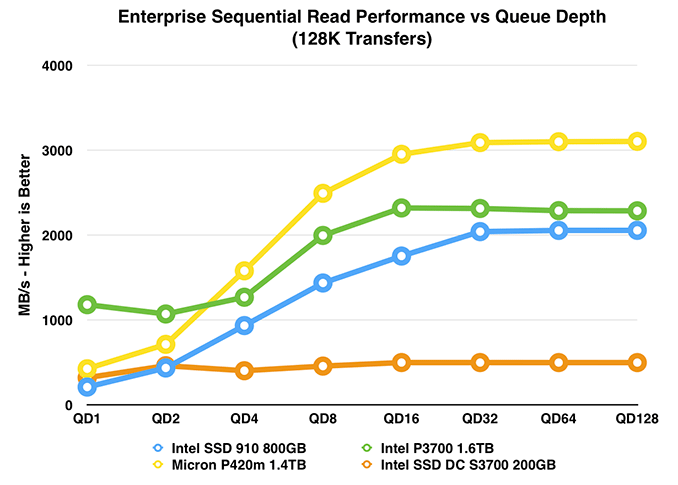
The biggest takeaway from this graph is just how much parallelism Intel manages to extract from each transfer even at a queue depth of 1. The P3700 delivers more than 1GB/s of bandwidth at QD1. That's more than double any of the other competitors here, and equal to the performance of 3.7x SATA Intel SSD DC S3700s. Note that if you force the P3700 into a higher power, 25W operating mode, Intel claims peak performance hits 2.8GB/s compared to the 2.2GB/s we show here.
With NVMe you get a direct path to the PCIe controller, and in the case of any well designed system the storage will communicate directly to a PCIe controller on the CPU's die. With a much lower overhead interface and protocol stack, the result should be substantially lower latency. The graph below looks at average
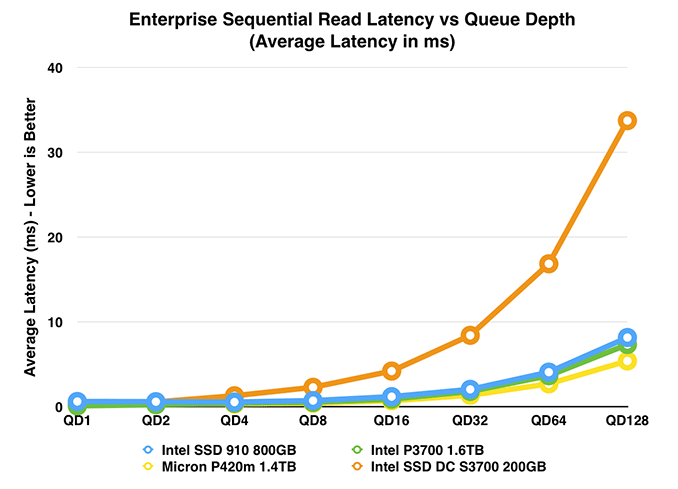
The P3700 also holds a nice latency advantage here. You'll be able to see just how low the absolute latencies are in a moment, but for now we can look at the behavior of the drives vs. queue depth. The P3700's latencies stay mostly flat up to a queue depth of 16, it's only after QD32 that we see further increased latencies. The comparison to the SATA based S3700 is hilarious. The P3700's IO latency at QD32 is lower than the S3700 at QD8.
The next graph removes the sole SATA option and looks at PCIe comparisons alone, including the native PCIe (non-NVMe) Micron P420m:
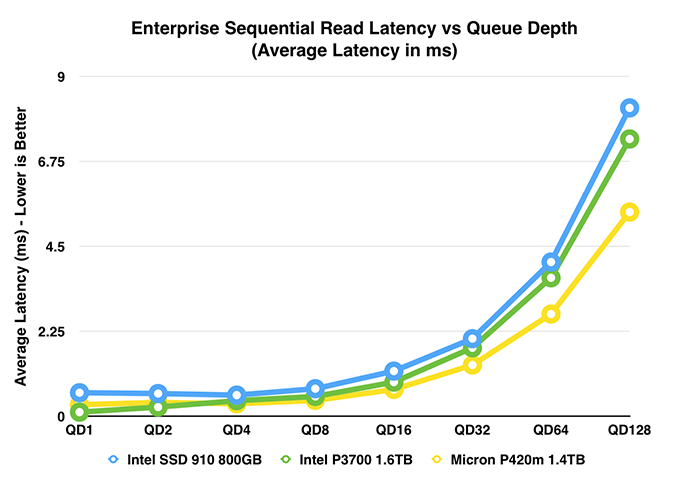
Micron definitely holds the latency advantage over Intel's design at higher queue depths. Remember that the P420m also happens to be a native PCIe SSD controller, it's just using a proprietary host controller interface.
Sequential Write Performance
Similar to our discussion around sequential read performance, sequential write performance is still a very valuable metric in the enterprise space. Large log processing can stress a drive's sequential write performance, and once again it's something we see in our own server environment.
Here we fill the drive multiple times with sequential data and then write it back for a period of 3 minutes. I'm reporting performance in MB/s as well as latency over a range of queue depths.
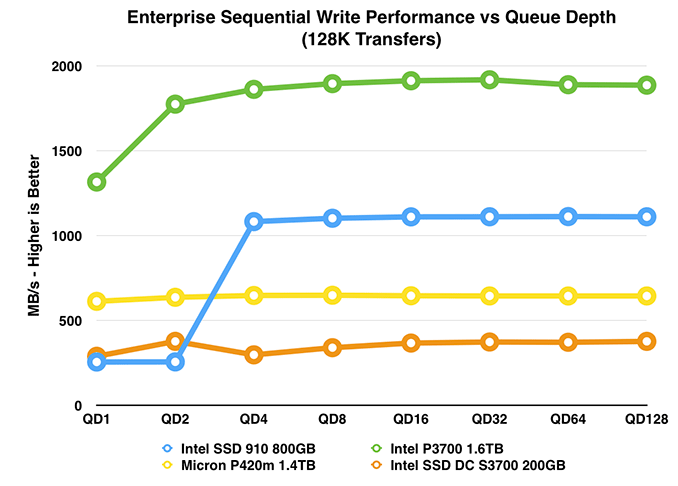
Once again we see tremendous performance at very low queue depths. At a queue depth of 1 the P3700 already performs better than any of the other drives here, and delivers 1.3GB/s of sequential write performance. That's just insane performance at such a low queue depth. By QD4, the P3700 reaches peak performance at roughly 1.9GB/s regardless of what power mode you operate it in.
The chart below shows average latency across the QD sweep:
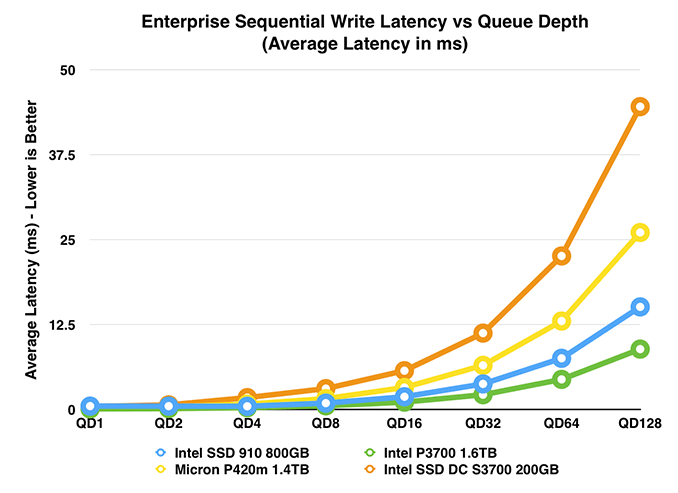
The P3700 continues to do extremely well in the latency tests, although Intel's original PCIe SSD didn't do so badly here either - its bandwidth was simply nowhere as good. Another way to look at it is that Intel now delivers better latency than the original 910, at substantially higher bandwidths. Micron's P420m manages to land somewhere between a good SATA drive and the P3700.
The next chart just removes the SATA drive so we get a better look at the PCIe comparison:
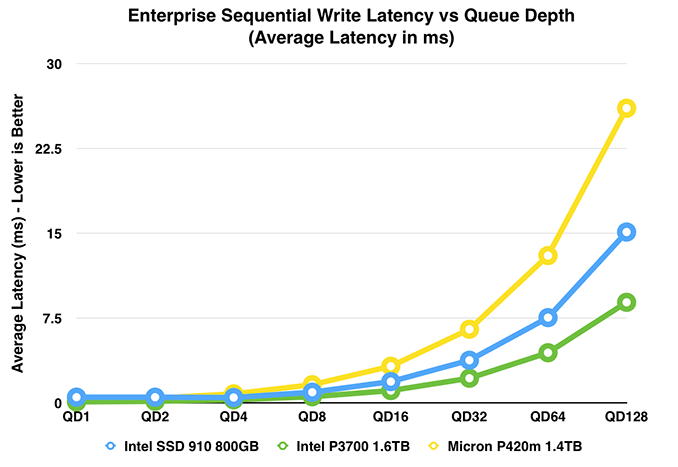










85 Comments
View All Comments
jamescox - Monday, June 9, 2014 - link
"Why isn't the new spec internal thunderbolt?"Thunderbolt is PCI-e x4 multiplexed with display port. Intel's new SSD is PCI-e x4. I don't think we have a reason to route display port to an SSD, so thunderbolt makes no sense. Was this sarcasm that I missed?
"At some point the hard drive should be replaced by a PCI-express full length card that accepts NAND cards, and the user simply buys and keeps adding cards as space is required. This can already be done with current technology, no reinventing the wheel required."
What protocol are the NAND cards going to use to talk to the controller? There are many engineering limitations and complexities here. Are you going to have 18 channel controller like this new Intel card? If you populate channels one at a time, then it isn't going to perform well until you populate many of the channels. This is just like system memory; quad channel systems require 4 modules from the start to get full bandwidth. It gets very complicated unless each "NAND card" is a full pci-e card by itself. Each one being a separate pci-e card is no different from just adding more pci-e cards to your motherboard. Due to this move to pci-e, motherboard makers will probably be putting more x4 and/or x8 pci-e slots with different spacing from what is required by video cards. This will allow users to just add a few more cards to get more storage. It may be useful for small form factor systems to make a pci-e card with several m.2 slots since several different types of things (or sizes of SSDs) can be plugged into it. This isn't going to perform as well as having the whole card dedicated to being a single SSD though. I don't think you can fit 18 channels on an m.2 card at the moment.
Anyway, most consumer applications will not really benefit from this. I don't think you would see too much difference in "everyday usability" using a pci-e card vs. a fast sata 6 drive. Most consumer applications are not going to even stress this card. I suspect that sata 6 SSDs wil be around for a while. The SATA Express connector seems like a kludge though. If you actually need more performance than sata 6 (for what?), just get the pci-e card version.
jeffbui - Thursday, June 5, 2014 - link
"I long for the day when we don't just see these SSD releases limited to the enterprise and corporate client segments, but spread across all markets"Too bad Intel is all about profit margin. Having to compete on price (at low profit margins) gives them no incentive to go into the consumer space.
sethk - Saturday, June 7, 2014 - link
Hi Anand,Long time fan and love your storage and enterprise articles, including this one. One questions - what the driver situation on NVMe as far as dropping one of these into existing platforms (consumer and enterprise) and being able to boot?
Another question is regarding cabling for the non-direct PCIe interfaces like SataExpress and SFF-8639? It would be great if you could have some coverage of these topics and timing for consumer availability when you do your inevitable articles on the P3600 and P3500 which seem like great deals given the performance.
T2k - Monday, June 16, 2014 - link
How come you did not include ANY Fusion-IO card? In enterprise space they are practically cheaper than the P3700 and have far bigger sizes, for less money, consistently low latency, not to mention advanced software to match it... was it a request from Intel to leave them out?SeanJ76 - Wednesday, May 20, 2015 - link
Intel has always been the best in SSD performance, and longevity. I own 3 of the 520 series(240GB) and have never had a complaint.